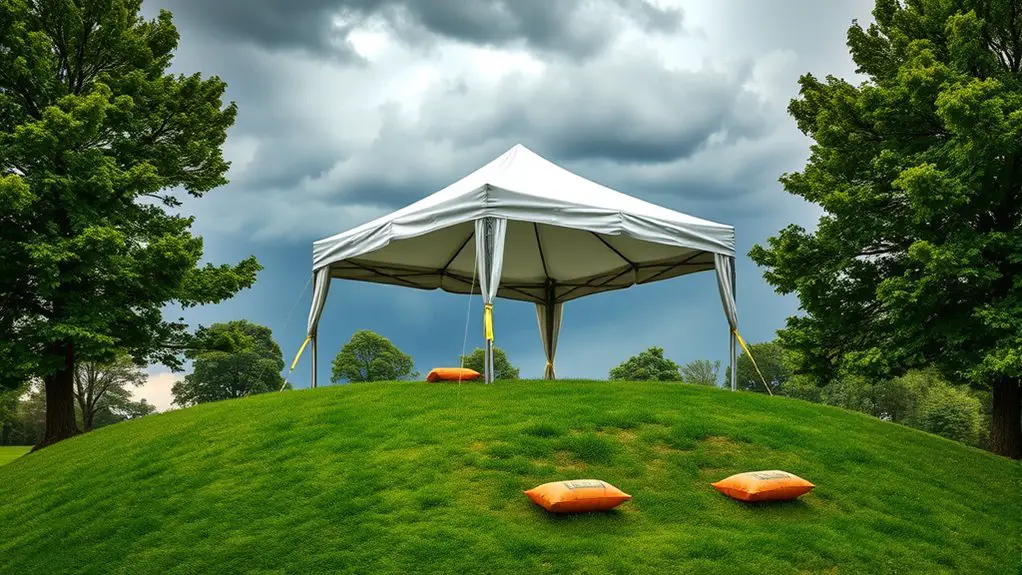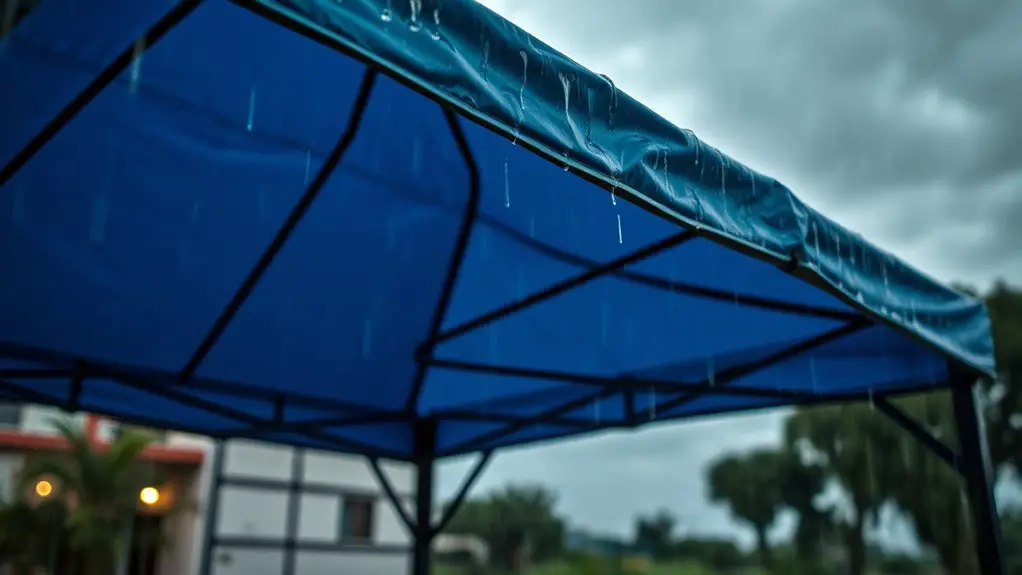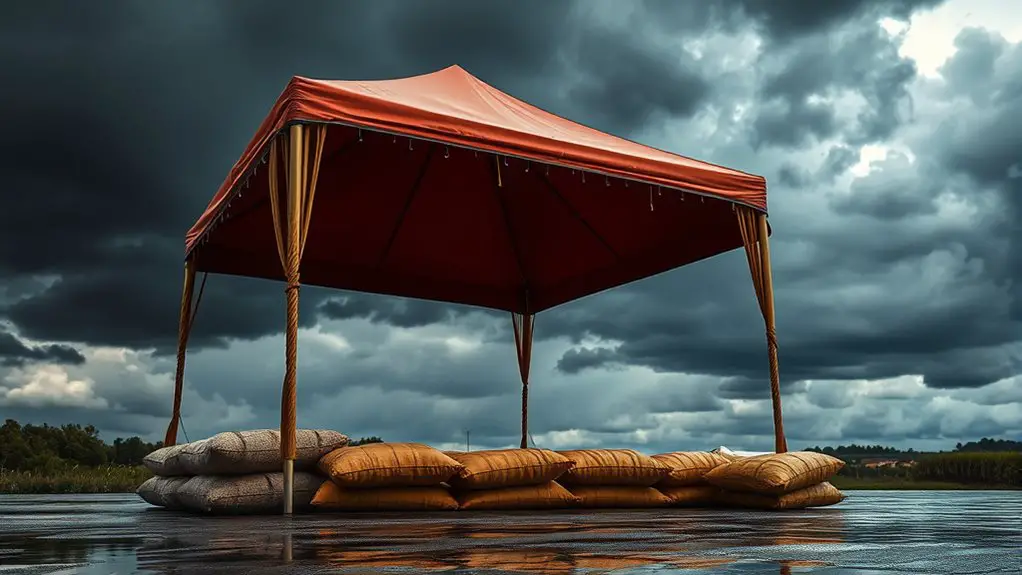To reinforce a temporary gazebo for heavy rain, start by choosing a well-drained, elevated location. Secure the base with sandbags or water containers for stability. Use nylon or polyester guy lines to counteract wind forces. Reinforce the frame with diagonal braces and vertical supports, ensuring all connections are secure. Opt for a peaked, waterproof cover to facilitate drainage. Regularly inspect for wear and debris to maintain integrity. There’s more to contemplate for long-term durability and protection.
Choose the Right Location for Your Gazebo

Choosing the right location for your gazebo is vital, especially if you’re anticipating heavy rain. Start by examining the ideal terrain; flat, well-drained ground is essential to prevent water pooling around your structure. Avoid low-lying areas where runoff collects, as this could compromise your gazebo’s stability.
Next, consider sunlight exposure. Placing your gazebo where it receives morning light can help dry any moisture quickly, reducing the chances of mold or mildew. However, you might want to position it near trees or other natural barriers to shield it from gusty winds that can accompany storms. Additionally, ensure you assess sun and shade exposure to strike a balance between sunlight and protection from harsh weather.
Think about accessibility, too; you want easy access to your gazebo for both you and your guests. By carefully reviewing these factors, you can create a serene outdoor retreat that stands resilient against the elements while providing you the freedom to enjoy your space, rain or shine.
Secure the Base With Weights
To guarantee your gazebo withstands heavy rain, strategically placing weights at the base is essential. Sandbags can provide a solid anchor, while water containers offer a flexible solution that can be adjusted as needed. By securing the base effectively, you’ll enhance stability and reduce the risk of your gazebo being compromised by strong winds or downpours. Additionally, proper anchoring methods are crucial for stability in windy conditions.
Use Sandbags Strategically
While it’s tempting to rely solely on the structure of your temporary gazebo, securing it with sandbags can greatly enhance its stability during heavy rain. Proper sandbag placement is essential; it can prevent your gazebo from lifting or collapsing under pressure. Aim for strategic locations, ensuring even distribution of sandbag weight.
| Location | Number of Sandbags | Weight per Sandbag |
|---|---|---|
| Corners | 2 | 25 lbs |
| Middle Sides | 1 | 25 lbs |
| Base Poles | 1 | 30 lbs |
| Total Weight | 120 lbs |
Consider Water Containers
Water containers can serve as an effective alternative or supplement to sandbags for reinforcing your temporary gazebo during heavy rain. By leveraging water weight, you can create a stable foundation that counters strong winds and heavy downpours. Choose durable containers, like plastic barrels or heavy-duty garbage bins, and fill them with water to maximize their effectiveness.
When it comes to container placement, strategically position them at each leg of the gazebo to guarantee even weight distribution. This not only enhances stability but also prevents the structure from shifting during inclement weather. Make certain to secure the lids tightly to prevent spillage. By using water containers wisely, you’ll enjoy peace of mind knowing your gazebo is well-protected against the elements.
Use Guy Lines for Extra Stability

When facing the threat of heavy rain, securing your temporary gazebo with guy lines can greatly enhance its stability. These lines act as anchors, countering the forces of wind and rain to prevent your gazebo from collapsing. You can choose from various guy line types, such as nylon or polyester, based on your specific needs. Additionally, implementing anchoring techniques will further stabilize your gazebo during inclement weather.
Here’s a quick reference table for securing techniques:
| Guy Line Type | Recommended Use | Advantages |
|---|---|---|
| Nylon | Moderate winds | Strong and durable |
| Polyester | Heavy rain | UV resistant |
| Reflective | Night visibility | Enhanced safety |
Reinforce the Frame With Additional Supports
To enhance your gazebo’s stability during heavy rain, consider adding diagonal bracing and vertical supports to the frame. These reinforcements distribute stress more evenly and reduce sway, ensuring your structure withstands harsh conditions. Don’t forget to secure everything with anchors for maximum resilience against wind and water. Additionally, using leg weights can further increase stability and prevent displacement during severe weather events.
Use Diagonal Bracing
Incorporating diagonal bracing into your gazebo’s frame can greatly enhance its structural integrity, especially during heavy rainstorms. By using effective diagonal bracing techniques, you can considerably reduce lateral movement and prevent potential collapse. Here are some essential tips to take into account:
- Choose strong bracing materials: Opt for steel rods or wooden beams.
- Position braces correctly: Install them from the top corners to the opposite bottom corners.
- Secure connections: Use bolts or screws to firmly attach the bracing to the frame.
- Check for tension: Verify the braces are taut to maximize their effectiveness.
With these strategies in place, you’ll bolster your gazebo against heavy rain, guaranteeing your outdoor space remains safe and enjoyable.
Add Vertical Supports
Adding vertical supports can greatly enhance your gazebo’s resilience against heavy rain. By strategically incorporating vertical support materials like steel pipes, wooden posts, or even PVC, you can create a more robust framework. Begin by identifying key areas in your temporary gazebo design where additional support is needed—typically near corners and along the sides. Secure these vertical supports to the existing frame, ensuring they’re plumb and anchored properly. You might use brackets or bolts for a solid connection. This reinforcement not only helps distribute the weight of pooling water but also minimizes swaying during strong winds. With these enhancements, your gazebo can withstand the elements, allowing you to enjoy outdoor freedom even in less-than-ideal weather conditions.
Secure With Anchors
Once you’ve integrated vertical supports, the next step in reinforcing your gazebo involves securing it with anchors. The right anchor types and anchor placement are vital to guarantee stability against heavy rain. Here are essential points to take into account:
- Spiked anchors: Drive these into the ground for secure, temporary fixation.
- Screw anchors: Ideal for firm soil, providing extra grip and resistance.
- Weight bags: Fill them with sand or gravel to add stability without permanent alterations.
- Ratchet straps: Connect your gazebo to nearby structures or trees for additional support.
Ensure Proper Drainage to Prevent Water Accumulation
To guarantee your temporary gazebo withstands heavy rain without succumbing to water accumulation, proper drainage is essential. Start by evaluating the ground beneath your gazebo; make sure it’s sloped away from the structure to encourage water flow. Installing drainage solutions like a simple trench or channel can effectively direct rain away from the base. If your gazebo is placed on a patio or deck, consider incorporating drain mats or grates that allow water to seep through while preventing pooling.
Additionally, elevate the gazebo with pavers or blocks to enhance airflow beneath, further reducing water accumulation risks. You might also think about positioning rain barrels at strategic points to collect excess water, thereby minimizing overflow. By implementing these drainage strategies, you’ll protect your gazebo and create a more enjoyable outdoor space, allowing you the freedom to relax, even when the skies open up. Furthermore, selecting a gazebo with a peaked roof design can significantly improve drainage and reduce the risk of pooling.
Opt for a Waterproof Cover

A waterproof cover is vital for protecting your temporary gazebo during heavy rain. Choosing the right materials not only guarantees durability but also offers peace of mind when storms roll in. Here are some key aspects to take into account:
- Waterproof materials: Look for high-quality fabrics like polyethylene or vinyl that resist water penetration.
- Proper fit: Make sure the cover snugly fits your gazebo to prevent wind from lifting it.
- UV protection: Select covers that also provide UV resistance to prolong their lifespan.
- Ventilation: Covers with vents help reduce condensation and prevent mildew.
Once you’ve invested in a waterproof cover, remember that cover maintenance is significant. Regularly check for tears or wear and clean the cover to maintain its effectiveness. This way, you’ll enjoy your outdoor space without the worry of water damage, allowing you to embrace the freedom of your temporary gazebo, rain or shine! Additionally, consider using water-repellent sprays for added protection against moisture.
Regular Maintenance and Inspections
Although it may seem tedious, regular maintenance and inspections of your temporary gazebo are essential for guaranteeing its longevity and stability during heavy rain. Start with routine checks of the frame and joints; look for any signs of rust or wear that could compromise its integrity. Tighten loose screws and poles to maintain structural strength.
Regular maintenance of your temporary gazebo is vital for its durability and stability, especially during heavy rain.
Inspect the fabric for tears or water damage, as these can lead to leaks during storms. Use waterproofing sprays as a maintenance tip to enhance the fabric’s resistance to moisture. Additionally, ensure that you conduct regular inspections to catch any issues early on, which can help avoid costly repairs.
Don’t forget to clear debris from the roof and gutters to prevent pooling. If you’ve anchored your gazebo, check the stakes and weights regularly to verify they’re secure, especially after heavy winds or rain.
Taking these proactive steps not only safeguards your investment but also allows you to enjoy your outdoor space freely, knowing your gazebo can withstand the elements.
Frequently Asked Questions
Can I Use a Tarp Instead of a Waterproof Cover?
You can use a tarp instead of a waterproof cover. Tarps offer advantages like affordability and portability, but consider waterproof alternatives for better durability. Just guarantee proper installation to maximize protection against heavy rain.
How Do I Prevent Mold Growth on My Gazebo?
To prevent mold growth on your gazebo, focus on mold prevention through humidity control. Guarantee proper ventilation, use moisture-resistant materials, and regularly clean surfaces to keep the environment dry and discourage mold development.
What Materials Are Best for Reinforcing the Frame?
If you’re looking to fortify your gazebo frame like it’s a fortress against a storm, consider using steel brackets and heavy-duty connectors. These reinforcement techniques will guarantee your structure stands tall, rain or shine!
How Often Should I Inspect My Gazebo for Damage?
You should inspect your gazebo regularly, ideally after each storm or harsh weather. Consistent gazebo maintenance guarantees you catch potential damage early, allowing for timely damage assessment and maintaining your outdoor space’s structural integrity and beauty.
Can I Leave the Gazebo up Year-Round in Rainy Climates?
Leaving a gazebo up year-round in rainy climates isn’t advisable without proper maintenance. Using weather-resistant materials can help, but regular inspections and upkeep are essential to guarantee its longevity and functionality in harsh conditions.

